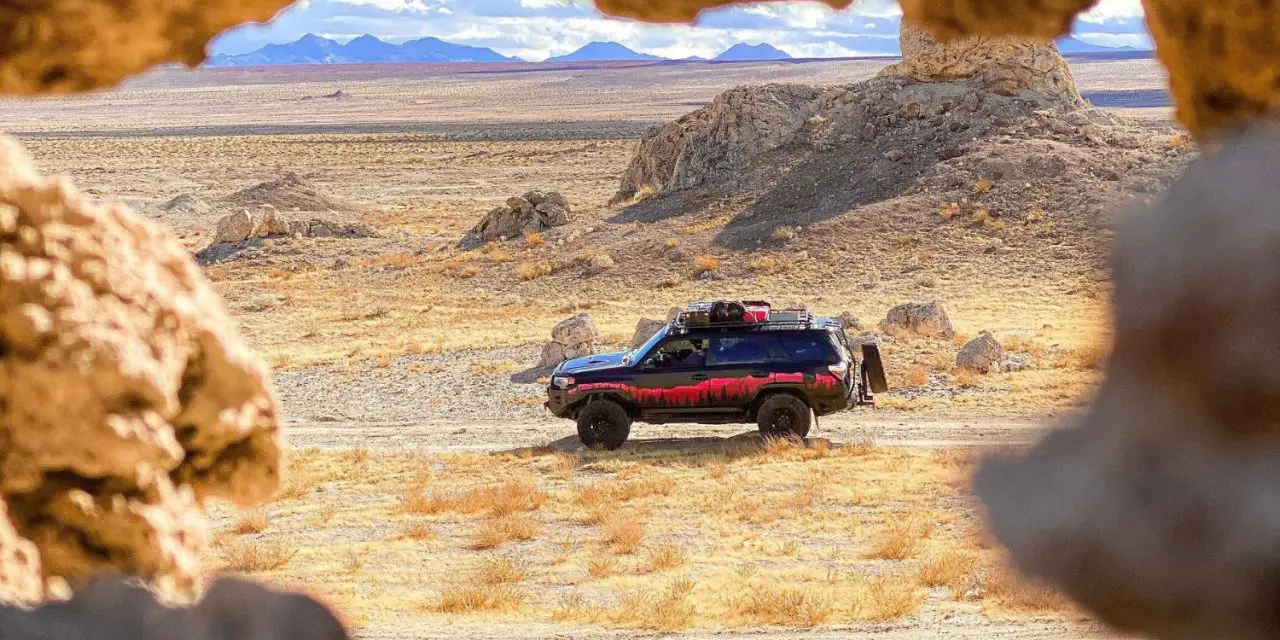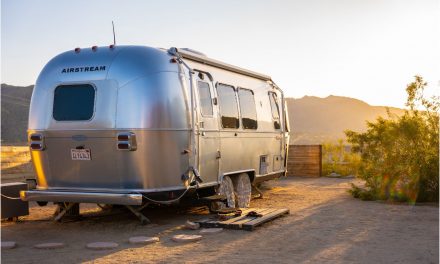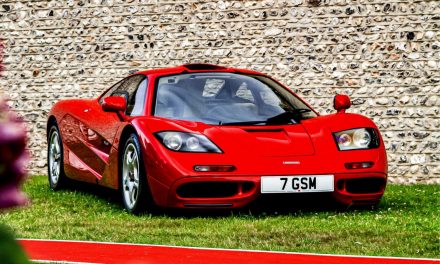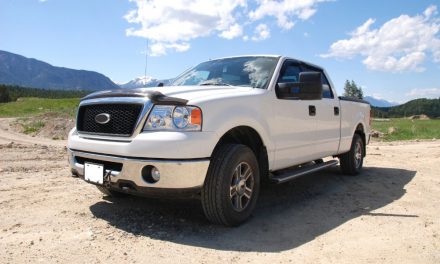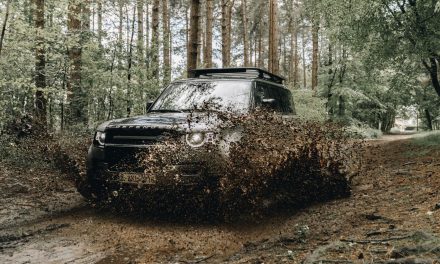Overlanding has become increasingly popular in recent years, as more and more people seek to explore the great outdoors. While many different vehicles can be used for Overlanding, SUVs have emerged as the preferred option for many enthusiasts. Thanks to their high ground clearance, four-wheel drive, and spacious interiors, many SUVs are well-suited for tackling rough terrain and carrying all the gear that you need for a successful expedition.
In this article, we will take a look at eight of the best SUVs for Overlanding, based on factors such as off-road capability, comfort, how much it can carry, and even gas mileage. Whether you’re looking for an affordable entry-level option or a top-of-the-line luxury SUV, you’re sure to find a vehicle that meets your needs on this list. So, let’s get started!
1. Toyota 4Runner TRD Pro (Our Choice)
| Ground Clearance | 9.6″ |
| Gross Vehicle Weight Rating (GVWR) | 6,300 |
| MSRP | $52,920 |
| Gas Mileage | 16 city / 19 highway |

Standout Features: Extreme reliability, Fox Shocks, many available aftermarket accessories.
The Toyota Tacoma is well regarded as one of the best pickup trucks for Overlanding, however, what if you wanted an SUV instead? That is where the Toyota 4Runner TRD Pro comes into the picture. This SUV offers all of the best things about the Tacoma, but makes it more usable for passengers, and adds plenty of interior cargo room (47.2 ft³). You can easily lay down the middle seats to allow you to place a small mattress and sleep wherever you are.
The TRD PRO 4Runner utilizes Fox Shocks, has tons of ground clearance just like its pickup sibling and is one of the most utilized Overlanding rigs on the market today. Mix all of its off-road capabilities with one of the most reliable engines and transmissions, and you have a recipe for success. It should be mentioned, due to its popularity for both Overlanding, but also off-roading in general, the TRD Pro has tons of aftermarket support, which is important in this industry.
2. Land Rover Defender 110
| Ground Clearance | 11.5″ |
| Gross Vehicle Weight Rating (GVWR) | 6,845 |
| MSRP | $51,700 |
| Gas Mileage | 17 city / 22 highway |
Standout Features: Smooth driving, Available 3rd Row, plenty of OEM off-road equipment available.
Yes, the Land Rover Defender made a big change! It may have switched to a unibody design, and is no longer as rough and tough as it used to be. However, it is an extremely formidable Overlanding vehicle. With tons of everything you need, such as ground clearance, gas mileage and more, but none of the downsides such as the poor reliability of the past, this vehicle makes for the perfect start to an Overlanding rig.
It’s luxurious interior means you are going to have plenty of comfort for those long drives off the beaten path, and its air suspension helps this even further. Speaking of air suspension, it is able to raise and lower itself from 8.5″ of ground clearance, all the way up to 11.5″, which is more than the well-known off-roader, the Jeep Wrangler.
Whether you are looking to do serious off-roading on your Overlanding trip with the 2-Door version, or towing your large camper with its 8,200 tow capacity, this is an awesome Overlanding rig base.
3. Ford Bronco Raptor
| Ground Clearance | 13.1″ |
| Gross Vehicle Weight Rating (GVWR) | 6,100 |
| MSRP | $68,500 |
| Gas Mileage | 15 city / 16 highway |
Standout Features: Fox Shocks, 13.1″ ground clearance, 37″ tires, 400 horsepower.
The new Ford Bronco Raptor deserves a spot on any list of off-road SUVs. This newly minted extension of the Ford Raptor family is a huge improvement over the base versions of the Bronco lineup. With an even wider wheel base (116.5″ ), Fox Shocks, 13.1″ of ground clearance, helped out by its 37″ tires, and it has 400 horsepower under the hood thanks to its 3.0L Twin-Turbo V6, it is an amazing off-road vehicle.
Now, off-roading bits aren’t everything when it comes to Overlanding. The Bronco Raptor is also very comfortable, and has plenty of cargo space, and is even a convertible (to enjoy the sun on your endeavor). That said, the Bronco, and the Raptor version are both very new vehicles, so they don’t quite have the aftermarket support of vehicles like the 4Runner and Wrangler quite yet…. but it will catch up.
4. Jeep Wrangler 392
| Ground Clearance | 10.3″ |
| Gross Vehicle Weight Rating (GVWR) | 6,100 |
| MSRP | $80,595 |
| Gas Mileage | 13 city / 17 highway |
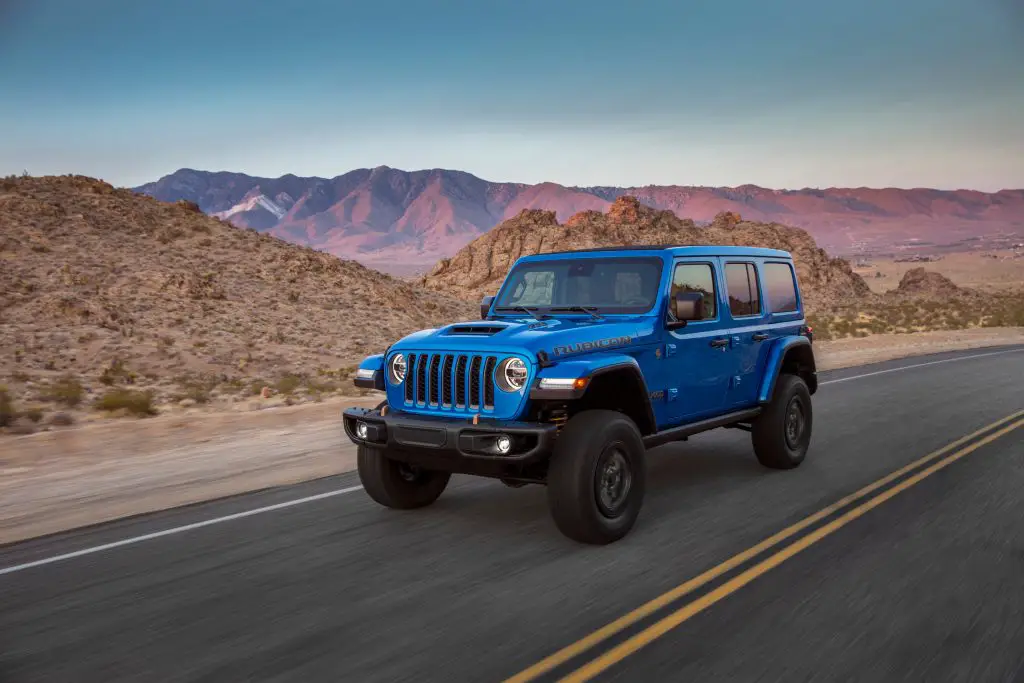
Standout Features: Extensive aftermarket support, 470 horsepower, reliable powertrain, Fox Shocks.
No list like this would be complete without the tried-and-true Jeep Wrangler. When Overlanding, it is essential to have a reliable and capable vehicle, and the Jeep Wrangler is one of the best options on the market. With the release of the Bronco Raptor above, Jeep stepped things up a notch by creating the 392 version of the Wrangler.
This upgraded version comes with a 6.4L Hemi, 470 horsepower, 4.5 second 0-60, incredible suspension travel, Fox Shocks, 33″ tires, and a host of electronic goodies to make your off-road travels a blast.
While I may personally prefer the Bronco Raptor, this Wrangler 392 is a force to reconned with. It will also have so much more aftermarket support for things that will make your Overlanding adventures much easier than many other vehicles on this list.
5. Lexus GX
| Ground Clearance | 8.1″ |
| Gross Vehicle Weight Rating (GVWR) | 6,600 |
| MSRP | $56,425 |
| Gas Mileage | 15 city 19 highway |
Standout Features: Ladder frame construction, transmission cooler, crawl control, extremely luxurious.
With its powerful V8 engine, rugged construction, and spacious interior, the GX is more than capable of taking you wherever you want to go. Plus, it comes with all the luxury features you’d expect from a Lexus, making it a comfortable place to spend time on long road trips. So if you’re looking for an Overlanding vehicle that can take you anywhere and keep you comfortable along the way, then the Lexus GX is a great choice.
This newest generation of Lexus GX is one of the best ones yet, especially since the Land Cruiser is no longer sold in the USA. It offers tons of off-road features, including cameras, transmission coolers, crawl control, and so much more.
The major drawback to the Lexus GX has to be its ground clearance. Due to its luxury vehicle stature, it only allows for 8.1″, which is one of the lower vehicles on this list.
- TOP 4 BEST ELECTRIC VEHICLES FOR OVERLANDING
- THE 8 BEST VEHICLES FOR A FAMILY OF FIVE (SUVS, TRUCKS AND ELECTRIC VEHICLES)
- ALL 94 SUVS THAT CAN TOW OVER 3500 (OR MORE) POUNDS
6. Jeep Grand Cherokee L
| Ground Clearance | 10.9″ |
| Gross Vehicle Weight Rating (GVWR) | 6,700 |
| MSRP | $41,395 |
| Gas Mileage | 19 city / 26 highway |

Standout Features: Available air suspension, luxurious, 10.9″ of ground clearance, 3rd row vehicle.
At this point in its life, the Jeep Grand Cherokee is a luxury vehicle, with so many luxurious amenities. However, its rise to luxury hasn’t gotten rid of its off-road features. With up to 10.9″ of ground clearance, the new longer wheel base version of this Jeep is a 3-row Overlanding rig to be reckoned with. With more cargo space than ever for your gear in the back (especially with the third row down), and better reliability than ever, I really do like the newest generation of Grand Cherokee.
It’s towing capacity of 6,200 pounds should get you by with room to spare with your off-road trailers, and roof top tents will have no problem sitting on the roof of the vehicle.
7. Ford Expedition Timberline
| Ground Clearance | 10.6″ |
| Gross Vehicle Weight Rating (GVWR) | 7,450 |
| MSRP | $70,450 |
| Gas Mileage | 16 city / 19 highway |

Standout Features: 10.6″ of ground clearance, tons of interior room, zone lighting, off-road shocks.
We are really starting to get into the lesser used Overlanding rigs with this one! However, hear me out. When Overlanding, you want a vehicle with a high clearance, tons of cargo space, and good gas mileage. The Ford Expedition matches all of that, especially with the new Timberline version.
The Timberline trim offers 10.6″ of ground clearance, off-road shocks, and even zone lighting (which lights up all around the exterior of the vehicle). It also has the same 3.5L EcoBoost V6 engine out of the Ford Raptor, and has trail control.
If you are looking to tow a trailer with your Timberline Expedition, you can easily do that with its 6,000 pound tow rating, and with its expansive interior and large roof, you have plenty of space to attach gear to the outside and inside of the vehicle.
8. Subaru Outback Wilderness
| Ground Clearance | 9.5″ |
| Gross Vehicle Weight Rating (GVWR) | 5,026 |
| MSRP | $37,695 |
| Gas Mileage | 22 city / 26 highway |
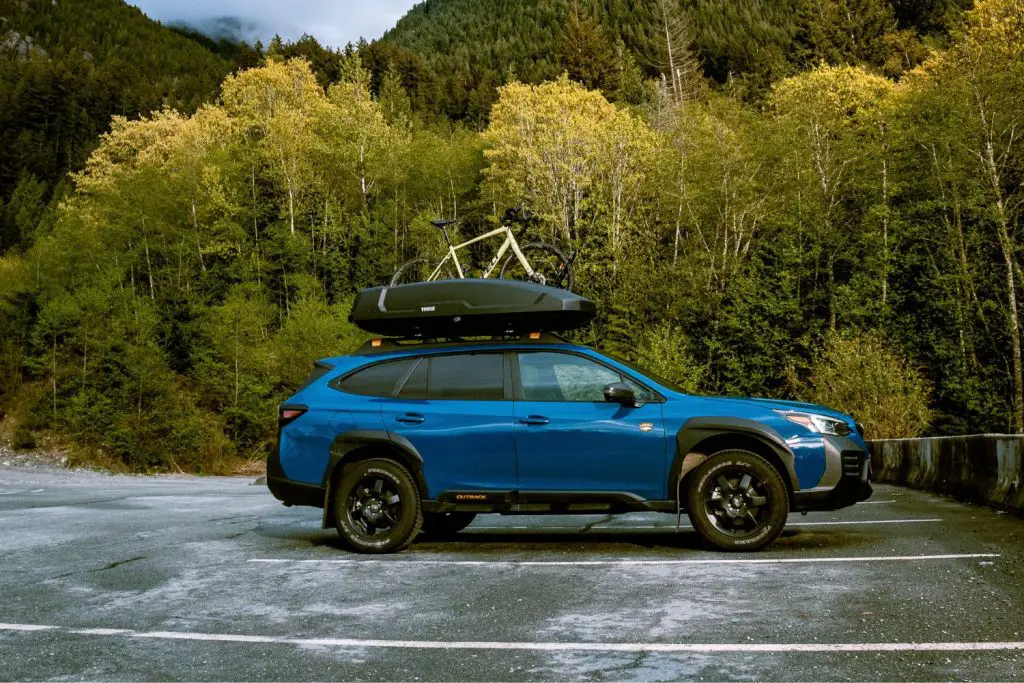
Standout Features: Compact design, great gas mileage, 9.5″ ground clearance, Subaru’s symmetrical AWD.
For those people that don’t want a massive vehicle, and don’t need a ton of off-road goodies, the Subaru Outback Wilderness is an awesome option for you. It may not be able to rock-crawl, or do the insane mudding that the other vehicles on this list should be able to do, but it does do an awesome job of getting you out into the woods, do some serious camping, and still be a fantastic around-town vehicle.
The Outback Wilderness also does all of this while getting you 26mpg on the highway! As for off-road features, the Wilderness has a respectable 9.5″ of ground clearance, a front skid plate, better tires, and improved departure and approach angles than the other Outback trim levels. You also can’t forget about the plastic cladding around each of the wheel arches… they are there too.
If there were a Subaru Outback I was going to buy today, this would be it!
Please Note: Yes, I know, the Outback is technically not an SUV. However the Wilderness trim definitely crosses that line in my mind.
What is Overlanding?
SUV Overlanding has become a popular way to explore the backcountry. Unlike traditional car camping, which involves driving to a campground and setting up a base camp, Overlanding is all about using your SUV to access remote locations, and then using it to camp instead.
This can involve anything from driving on forest service roads to crossing streams or hiking up mountains. To be prepared for any situation, Overlanders typically outfit their SUVs with a variety of camping and off-road gear.
This might include a rooftop tent, recovery gear, and a portable kitchen. By definition, Overlanding is an adventure that takes you off the beaten path. So whether you’re looking to explore your backyard or venture into the unknown, an SUV can help you get there.
What do you need out of a good Overlanding vehicle?
Approach Angle
An SUV’s approach angle is important while Overlanding because it determines how steep of an incline the vehicle can climb without getting stuck.
A higher approach angle means the vehicle can tackle more rugged terrain. When Overlanding, it is also important to have a strong underbody protection to guard against rocks and other obstacles. With proper equipment and preparation, an SUV can be an excellent choice for exploring the great outdoors.
Departure
The departure angle is the angle between the ground and the back of your SUV, and it determines how much clearance you have. If you don’t have enough clearance, your vehicle will bottom out and possibly sustain damage. When you’re driving off-road, it’s important to have a good departure angle so that you can navigate rough terrain without damaging your vehicle.
Depending on the terrain, you may need to air down your tires or add a suspension lift to increase your departure angle. With a little bit of planning, you can make sure that your SUV is able to handle anything that the trail throws at it.
Breakover Angle
One of the most important factors in choosing the right vehicle is the breakover angle. The breakover angle is the angle formed between the ground and the bottom of the vehicle’s chassis, and it determines how easy it will be to clear obstacles.
A vehicle with a high breakover angle will be less likely to get hung up on rocks or logs after the front wheels have made their way over them, making it ideal for Overlanding.
Cargo capacity
While many people enjoy taking their vehicles off-road, few have the necessary equipment to do so safely. One of the most important pieces of gear for any off-roading expedition is a vehicle with plenty of cargo capacity. An SUV with a large cargo area can provide the space needed to store food, water, and other supplies.
It can also be used to transport gear that would be difficult to carry on foot, such as tents and sleeping bags. In addition, a spacious cargo area can be used to store emergency equipment, such as a first-aid kit and a fire extinguisher. For anyone planning a journey into the wilderness, an SUV with ample cargo space is an essential piece of equipment.
Towing capacity
Anyone who has ever been Overlanding knows that there are a lot of different factors to consider when planning a trip. One of the most important, but often overlooked, is your vehicle’s towing capacity. Your towing capacity is the amount of weight your vehicle can safely tow without damaging the engine or suspension.
An SUV with a high towing capacity can be a lifesaver when you’re trying to get your gear to the campsite. It also comes in handy if you need to tow a trailer or another vehicle out of the mud. In short, an SUV’s towing capacity is one of the most important factors to consider when Overlanding. So before you hit the trail, make sure you know your vehicle’s limits.
Gas mileage
While many factors are important to consider while Overlanding, gas mileage should be at the top of the list. After all, the last thing you want is to be stranded in the middle of nowhere with an empty tank. An SUVs gas mileage becomes even more important when you factor in the increased weight of Overlanding gear.
A heavier vehicle will naturally consume more fuel, so it’s important to choose an SUV with a good fuel economy. Additionally, long-distance Overlanding trips often require traveling off the beaten path.
This can lead to some rough terrain, which can tax even the most fuel-efficient vehicle. For this reason, packing extra fuel is always a good idea when embarking on an Overlanding adventure. By taking gas mileage into account and being prepared for the worst, you can help ensure a successful trip.
Reliability
When embarking on an overlanding expedition, it is important to choose a vehicle that is both capable and reliable. SUV’s are often used for overlanding due to their four-wheel drive and high clearance. However, not all SUV’s are created equal. Some models are more reliable than others, and this can be the difference between a successful trip and a stranded vehicle.
When choosing an SUV for overlanding, it is important to consider its reliability record. Models with a history of mechanical problems are best avoided, as breakdowns are often difficult and expensive to fix in remote areas. A reliable SUV will help ensure a safe and enjoyable trip, regardless of the conditions.
Four-Wheel-Drive
An SUV with four-wheel drive is an ideal vehicle for Overlanding, as it provides the necessary power to all wheels, which helps a ton with getting you unstuck when you need it. That said, it by no means is necessary for a fun Overlanding trip, it will just make it so much easier.
Comfort
An SUV is the perfect vehicle for overlanding, as it provides both comfort and capabilities. One of the most important aspects of an SUV’s comfort is its suspension. When you’re driving on rough terrain, a comfortable suspension is crucial. It helps to smooth out the bumps and make the ride more pleasant.
In addition, an SUV’s cabin should be spacious and well-ventilated. You’ll likely be spending a lot of time in your vehicle while overlanding, so it’s important to have a comfortable space to relax in.
Conclusion
Overlanding is a great way to explore the world and experience new adventures. However, it’s important to choose the right vehicle for the job.
An SUV with four-wheel drive, a comfortable suspension, and plenty of storage space is ideal. Additionally, be sure to pick an SUV with a good fuel economy and reliability record. By following these tips, you can help ensure a successful overlanding trip.

